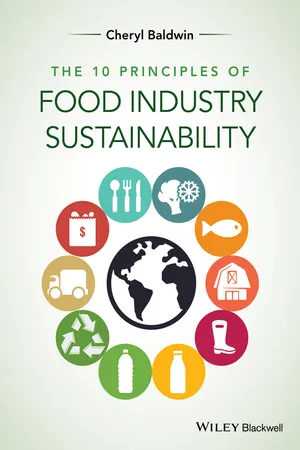
The 10 Principles of Food Industry Sustainability
Cheryl J. Baldwin
- English
- ePUB (apto para móviles)
- Disponible en iOS y Android
The 10 Principles of Food Industry Sustainability
Cheryl J. Baldwin
Información del libro
Although the food industry is beginning to make headway with its sustainability initiatives, substantially more progress is needed in order to feed the world's growing population sustainably. The challenge is that the topic of sustainability can seem overwhelming and there is limited information that is specific to the food industry.
Written by an experienced food industry professional with years of experience in sustainability, The 10 Principles of Food Industry Sustainability inspires and informs the progress required to nourish the population, revitalize natural resources, enhance economic development, and close resource loops. The book makes this complex topic approachable and actionable by identifying the most pressing sustainability priorities across the entire food supply chain and showing, with tools and examples, how producers, processors, packers, distributors, marketers and retailers all play a role in advancing improvement. The book begins with an overview of the Principles of sustainability in the food industry: what they are and why they matter. Subsequent chapters focus on each of the Ten Principles in detail: how they relate to the food industry, their global relevance (including their environmental, health, and social impacts), and the best practices to achieve the potential of meaningful and positive progress that the Principles offer. Specific examples from industry are presented in order to provide scalable solutions and bring the concepts to life, along with top resources for further exploration.
The Principles, practices, and potential of sustainability in the food industry covered in this book are designed to be motivating and to offer a much-needed and clear way forward towards a sustainable food supply.
Preguntas frecuentes
Información
1
Introduction to the Principles
1.1 The 10 principles of food industry sustainability
- Safe and highly nutritious food is accessible and affordable to promote and support a healthy population.
- Agricultural production beneficially contributes to the environment while efficiently using natural resources and maintaining a healthy climate, land, water, and biodiversity.
- Use of animals, fish, and seafood in the food supply optimizes their well-being and adds to environmental health.
- Producer equity and rural economy and development are strengthened with fair and responsible production and sourcing.
- Safe and suitable working conditions are provided to support employees across the supply chain.
- Food and ingredient processing generates resources and requires minimal additional inputs and outputs.
- Packaging effectively protects food and supports the environment without damage and waste.
- Food and ingredient waste and loss are prevented across the supply chain and what cannot be avoided is put to a positive use.
- Food and ingredients are efficiently delivered across the supply chain and to the consumer.
- The supply chain and consumers advance sustainable business and food consumption.
1.2 Principles–practices–potential
1.3 What is sustainability in the food industry?

1.4 The destructive course of the food system

